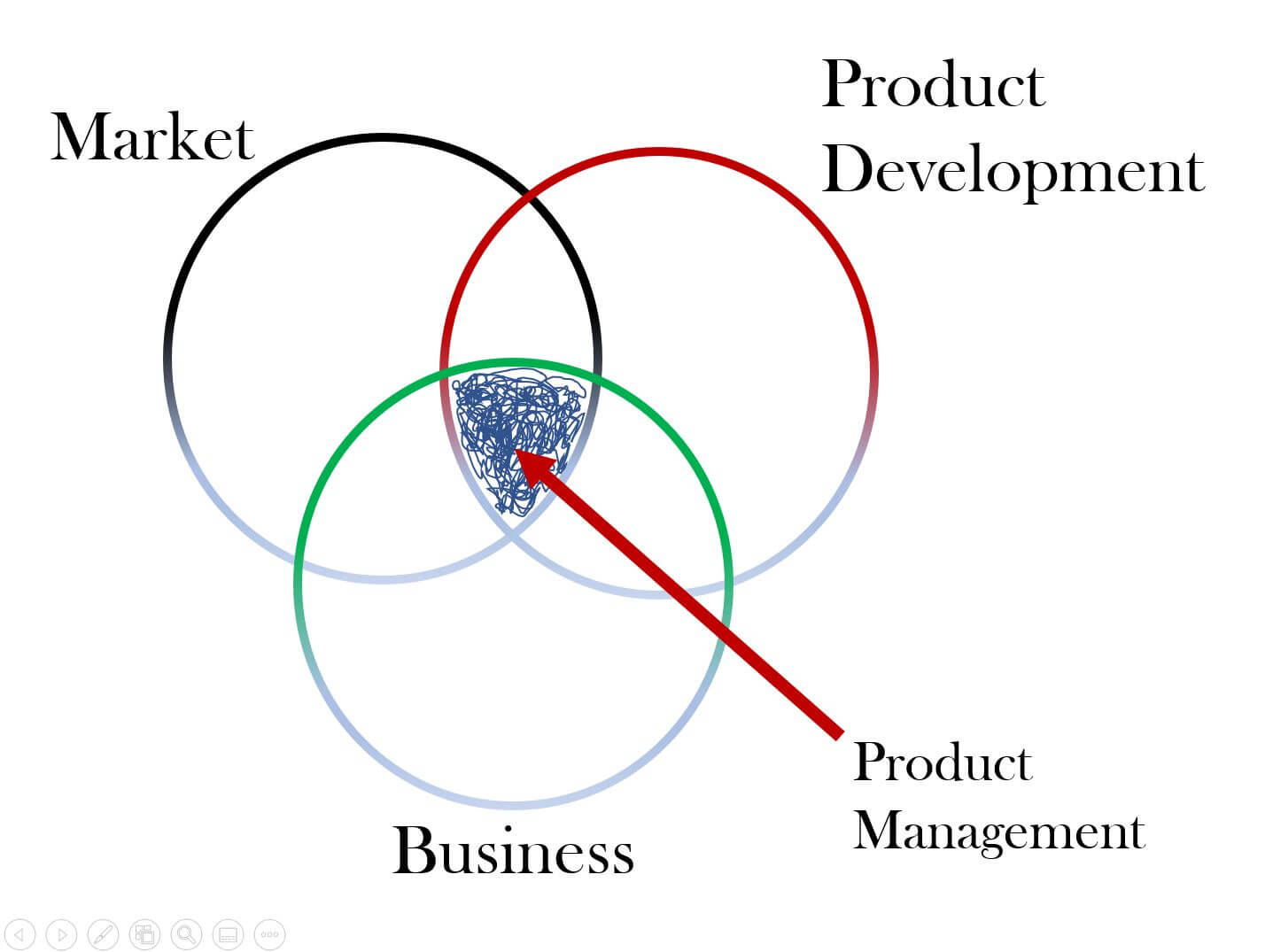It’s time to Build the B2B Product Manager Organization

Congratulations! You’ve been promoted! On your first day as a new B2B exec, your company’s Director of Public Relations wants to chat. Something about a press release. She says you’ll want to address stockholder concerns. To provide hope despite the weak economy and sluggish sales. To give a reason to believe. A reason to have faith in future profits. What will you say? Most likely, your first thought is not “As my first order of business, it’s time to develop the B2B product manager organization.”
But… maybe it should be.
After all, honeymoon periods don’t last. Not for B2B leaders. Not with a business in decline. And not when profits are fading gently, gently away. Meanwhile, those exciting new products, the ones that were supposed to save a whole division, are just sitting on the shelves; as if key pieces for a museum exhibit.
What now? You call your sales directors. And yet more calls to the BD directors. You hear a sad story. A bad story. Our customers only ask for one thing: lower prices. The value propositions? Laughable. The new products? Totally undifferentiated from competitors’.

Almost certainly, poor B2B product management is at the root of the problem. It’s not hard to understand why. Think about your doctor. With an initial visit, there shouldn’t be treatment. Not at first. They begin with diagnosis. Tests for blood pressure and pulse. Listening to your breathing. Looking in your ears and eyes. Your throat. Perhaps there’s an MRI, CT scan, or X-ray. He’ll ask questions (an interview, if you will).
Moreover, it’s not just doctors. Plumbers, auto mechanics and your IT help desk all begin with diagnosis. And so should your product development. However, this does leave us with a question. Who’s job should this be?

Whose job is it to diagnose market problems?
For a doctor, diagnosis is part of their training. This is also true for plumbers and auto mechanics.
But engineers? Software developers? Product designers? Oddly enough, diagnosis is not part of their training. And in practice, they aren’t even given time to diagnose. Instead, their hours are spent creating the next product. Or supporting current ones. As a result, their days are full.
What about sales? Yes, they do diagnose – sort of. Though, for the purpose of selling current products. Not for creating new ones. And a sales person has a customer view rather than a market segment view. Therefore, unless your business is custom products only, that’s not good enough for product development.
What about marketing? Well, this is closer. “Closer” because diagnosis is a marketing function. However, this isn’t mar-comm. Not press releases, A-folders, and trade shows. Instead, diagnosis is strategic. It’s product marketing with a long term view.
Diagnosing market problems and working with development to bring new products to life. It’s called product management.
Why do B2B companies struggle to develop product management organizations?
First, consider which types of companies have the strongest product management? It’s those that can’t afford to be wrong: high tech and software. It’s where solutions change quickly. So fast, in fact, that a company won’t survive long without market insight. And unfortunately, there’s always a better solution around the corner. Solve the wrong problem – and you may be out of business.

THE FORTRESS BECOMES A PRISON
Large B2B companies have assets that protect them from immediate destruction. They live behind fortresses. Not made of stone, but of patents, of scale, and value chain complexities. Patents lock out competitors. Economies of scale keep costs low and quality high. Value chain complexities make it difficult for customers to leave.
Consider a food additive firm that makes a coloring ingredient. Why would their downstream food producers change? A switch would be risky, time-consuming and costly. And for what benefit?
The same for the company that makes hoses for diesel engines. For one that makes copper wire for DC motors. Why would a customer change? No thanks. The status quo is fine.
Therefore, though the assets of a B2B firm inoculate them from a quick death, they make them vulnerable to a slow one. When the protective walls prevent development of the B2B product manager team, this fortress becomes a prison. 
Like the steamroller scene from the Austin Powers movie, it’s a disaster that everyone sees. Even as it slowly approaches. And bystanders are powerless to stop it.
INVESTORS KEEP US HONEST
However, there is a group to keep B2B executives from becoming too comfy within the castle walls. We call them investors. They want profits. They demand growth.
While a bigger struggle for B2B, all firms will benefit from improved product management. To get better, we should begin with the biggest, most pervasive issues that stand in our way. We’ve identified four major challenges that hobble product management for most companies. Let’s take a look.

The first challenge is that the product manager role is not well understood.
Here’s a definition as presented on IBM’s hiring site:
The Product Manager develops products by identifying potential products; conducting market research; generating product requirements; determining specifications, production timetables, pricing, and time-integrated plans for product introduction; developing marketing strategies.
This is a good start. To be sure, it at least helps explain why the product manager is often called the “CEO of the product.”
Let’s continue with Wikipedia’s definition:
“A product manager is a professional role which is responsible for the development of products for an organization, known as the practice of product management. Product managers own the business strategy behind a product (both physical and digital products), specify its functional requirements and generally manage the launch of features. They coordinate work done by many other functions (like software engineers, data scientists and product designers) and are ultimately responsible for the business success of the product.”
This is more specific, with useful details. It does not differentiate between the B2C and the B2B product manager. But let’s condense product management to its core elements. And build the definition from there. Here’s our definition:
A product manager guides the strategy for new and current products by representing the customer as well as the business interests throughout product development.

To quote Socrates, “The beginning of wisdom is a definition of terms.” So let’s explore the three main tenets of this definition:
GUIDING THE STRATEGY
“Guiding the strategy” means that the product manager works with development to address customer requirements with relevant features. To do so, the product manager must not only understand the customer, but also the competitive landscape: competitors’ businesses as well as their products. They must understand emerging trends for technologies, regulations, and global dynamics. From this basis, the product manager builds strategies. Dynamic product strategies that will remain stable. And yet, will flex with new insights over the years.
REPRESENTING THE CUSTOMER
“Representing the customer” means that the product manager must understand customer needs. They must diagnose market problems. Those that products should address. A product manager must be fully committed to this task. Consequently, they will attend shows, spend time with customers, and read secondary research reports. They will immerse themselves in their customers’ world as much as possible. Researching their pain – or even better – feeling it directly by walking in their customers’ footsteps, both figuratively and literally. A product manager does whatever it takes to get this insight. Executing primary and secondary market research projects are a way of life. And of course, New Product Blueprinting is a B2B-optimized system for this research and analysis.
THE BUSINESS INTERESTS
“As well as the business interests” means that the product manager seeks to optimize the business’s profitability, growth, and market share goals. As such, they must understand the basics of strategy, economics, marketing, operations, finance, and even accounting. They must also have a firm grasp on select individual topics such as pricing, forecasting, and data analysis.
The product manager’s role lives within the intersection of the market, of product development, and of the business.
The product manager lives within the intersection of the market, product development, and the business. It’s a strategic job. A position that demands a balanced perspective.

A product manager must maintain this balanced view
The Sales Perspective
Typically, most functional areas will not maintain this balance. They use different metrics from a singular perspective. For example, sales wants to say “yes” to the customer, always. This might be good for short-term business but is a poor innovation practice. Of course, customers want lower prices (Damaging margins). Of course, a customer wants a custom feature for their application (Damaging cost structure and increasing manufacturing complexity). The sales role doesn’t think about the long term consequences, but the product manager must.
The Business Perspective
Moreover, only considering the business interests is no better. Finance wants higher prices. But alas, this is a risky move without knowing the impact on customer value. Operations will push for lower inventories. Lower WIP and fewer finished goods to free up cash. Operations is looking at cash flow and ROA. They don’t naturally follow the link between reduced inventories the time to fill an order. And the resulting impact on future business. Product managers had darn well better understand what those consequences would be.
The pursuit of a science project rarely results in a superior value proposition.
The Product Development Perspective
What about a technical perspective? From product development? Unfortunately, this is also no better. Product development will want to cheapen the product to achieve cost savings goals. Or just as bad, they may fall in love with a new technology. This love begins a courtship and a rationalization as to how customers ache for these new features. Sadly, this affair doesn’t end well. The pursuit of a science project rarely results in a superior value proposition.
For better or worse, it’s natural for each functional area to have their own success metrics. Unfortunately, this even includes leadership – using SVA in an ill-fated attempt to shrink the firm to greatness. Product managers must stand in the gap and maintain a strategic perspective.

Our second challenge is the lack of candidates with proper training.
First, what training does a product manager need? Begin with a balanced business education. An MBA should generally be a minimum requirement. A product manager needs the foundation of strategy, marketing, operations, accounting and finance.
Further, a product manager need specific training in product development (phased gate development, portfolio management, etc.), voice-of-the-customer methods, personas, idea generation, creating specifications, road mapping, concept testing, etc.
Specialized product manager training
Make no mistake, large business schools are beginning to recognize this as an opportunity. Master’s programs in product management have been added at institutions such as Carnegie Mellon and the University of Texas. Others, such as NYU, have added product management as a specialty within their MBA program.
Meanwhile, even Harvard Business School has entered the fray. As a strategy, they’re utilizing independent product management gurus, such as Melissa Perri of Produx Labs, to teach within their highly-touted MBA program.
For B2B and large industrial companies, the New Product Blueprinting curriculum addresses most skill areas, especially for the B2B product manager. Likewise, for high tech and software businesses, Pragmatic Marketing has offered product management programs for many years. And though perhaps more from an academic perspective, the NPDP (New Product Development Professional) Certification through PDMA (Product Development and Management Association) provides valuable specific skills.
Regarding the specific training, here are some do’s and don’ts:
- Do commit to product management training for new and aspiring product managers.
- Do provide on-going training for experienced product managers.
- Don’t allow engineering and technical teams to proceed without a product manager to represent the market and the business
- Do form long term relationships with training companies for the purpose of keeping the troops apprised of the latest approaches.
- Don’t be concerned about differences in terminology between Method A and Method B. No method is perfect, and the best product managers will benefit from learning different perspectives.
- Don’t be concerned about how or if the training perfectly matches with your current development system or other innovation methods that you’ve internalized.
- Don’t ever, ever, ever reduce training investments because of market downturns. No company ever went broke because it spent too much on training or because it understood customers too well. However, plenty have suffered due to poorly qualified product managers. Do err on too much training.

Our third challenge is the difficulty of keeping product managers on the job long enough to gain sufficient experience.
It takes time to become good at anything. For example, you can’t learn to drive, to swim, to play guitar, to cook, or conduct brain surgery by reading alone. You learn to do things by doing them. It takes 3-4 years for a product manager to be truly proficient. Why so long?
Consider the upfront voice-of-the-customer work within the fuzzy front end. Afterwards, the product manager works with development to bring the product to market. Then the product launches. That’s one cycle. It takes multiple cycles for a product manager to become capable. And even more for mastery.
WE NEED PROFESSIONAL PATHS WITHIN PRODUCT MANAGEMENT
Additionally, product managers have little incentive to stay in the position. As compared to other careers, few companies have professional paths within product management. In engineering, you can begin as an engineering co-op student. Then you can join full-time as an Engineer I. Then Engineer II, or Senior Engineer, and so forth. You can climb the company ladder, all within the engineering function. Likewise, you can also do this within sales, procurement, finance, accounting, and operations. Pretty much any other function.
And when we have high performing product managers on staff, we tend to promote them to greater opportunities. With no financial incentive to stay in product management, they leave. And the company suffers for it.
What about technical knowledge?
Interesting question. Shouldn’t a product manager for software be able to code? What about a product manager for hydraulic actuators? Surely, they need must a mechanical engineering background, right? And shouldn’t a product manager for electronic devices know electrical engineering? While this might be counter intuitive, the answer is “no.” Not really.
Truthfully, a good product manager will be effective regardless of their engineering chops. And in fact, keeping a distance from any particular technology actually helps to reduce biases as to what products should be developed. Typically, electrical engineers envision electrical solutions. Software developers envision software solutions, etc. Technical experts can overcome these biases, but there is a certain advantage to being tech agnostic.

Our fourth challenge: The product manager is tasked with too many tactical duties.
Strategic product manager activities are both important and non-urgent. Moreover, consider other important/non-urgent activities that people do. Brushing their teeth. Getting the required vaccines. Maintaining their cars. If a person does not brush their teeth one morning, the teeth will not all rot out that evening. Without a tetanus vaccine, you will not develop lockjaw within a week. If you neglect to change the oil in you car, it will continue to run. For a while.
What are some of these important and non-urgent product management tasks? Interviewing customers. Conducting quantitative market research. Studying the competition. Participating in brainstorming sessions. Analyzing customer data. If these do not get done in a particular week, market share doesn’t evaporate immediately. Obviously, the business will continue to operate profitably. For a while.
The problem with good intentions
Unfortunately, the product manager is often asked to support other functions with shorter term objectives. And if we’re not careful, these functions will fill the product manager’s calendar with a truckload of “urgent” matters. The sales director will insist that the product manager should participate in sales calls, or work trade shows. The marketing director will ask the product manager to develop training materials for distributors. Further, the engineering manager will ask them to attend committees on warranty issues.
In truth, there’s nothing wrong with participating in these activities. However, if left unchecked, they’ll consume the entire schedule. Leaving no time for the important, non-urgent, product management tasks.

But what about the B2B product manager organization?
B2B firms have less developed organizations than B2C. But remember the previously mentioned product management graduate programs? They advertise lucrative salaries for graduates – but specifically refer to placement within high tech and software. This is because B2B firms are not paying those same salaries.
However, exploit this as an advantage. Your B2B competition almost certainly has poor product management. Win the future by addressing the four challenges of developing a B2B product manager organization:
- Understand the strategic role of product management.
- Make it a priority to find candidates with the proper training. Commit to their continuing education.
- Develop an organization that sticks. Create financial incentives to keep product managers long enough to become proficient and longer. Everybody wins if they can contribute for many years.
- Ensure that product managers have the time to perform their core jobs, understanding customers and working with development, before filling their hours supporting other parts of the business.
It’s time to assemble the B2B Product Manager team
By and large, B2B firms do a poor job developing B2B product managers. This could be a great source of competitive advantage for your firm. Make sure your team will have the training, the time, the correct priorities. You know those stories that we tell to Wall Street? The ones that feel a bit… fabricated? And perhaps, just perhaps… it’s because they’re a bit too optimistic? It’s time for a real story. An interesting story. One that you’ll be proud to tell.
An opportunity is at hand. A massive opportunity. It’s time to build the B2B product manager organization.
Comments